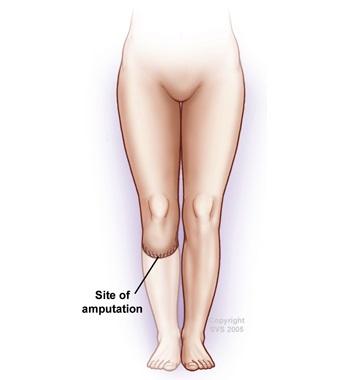- An advanced case of peripheral arterial disease (PAD) that causes a build-up of plaque in the artery wall and leads to the blockage of blood flow to a limb or extremity. If you have both PAD and diabetes, you are at a particularly high risk for requiring an amputation.
- Non-healing wounds, burns, frostbite, infection, injury, or tumors of the tissue or bone.

These procedures take place in the operating room. In most circumstances, you will be put to sleep under general or spinal anesthesia. The affected extremity will be prepped with an antiseptic solution and sterilely draped. An incision will be made that allows for sufficient healthy tissue to cover and protect the amputation stump, then the limb or extremity will be removed and the stump will be closed In cases of extensive infections, the stump may be closed during a second procedure to allow time for the infection to drain. When stumps are closed, internal drains may be placed to collect fluid or blood for a time, and be removed before discharge.
- Bleeding & Infection: This is possible following any surgical procedure. Your surgical team will stop any bleeding that occurs in the operating room, and a drain may remain after surgery to monitor post-operative bleeding. To prevent infection, pre-operative antibiotics are administered and your skin will be cleansed with an antiseptic solution. Still, infections sometimes occur and require treatment.
- Poor Wound Healing: Poor healing or wound breakdown may occur, particularly if your surgery was due to infection or poor blood flow. Your surgical team will meticulously check your incision during your hospital stay to monitor healing and watch for signs of infection.
- Blood Clots: Clots in the legs can develop due to lack of mobility after surgery. Low-dose blood thinners are often used to prevent clot formation.
- Phantom Pain: This sensation – that the limb is still there – sometimes occurs. It can often be treated with medication or therapy.
- Other Medical Conditions: Coronary artery disease, heart disease and diabetes can increase your risk for post-operative complications.
- Your vascular surgeon will give you instructions for how to prepare, including which medications to take the morning of the surgery.
- If you are not already in the hospital, you will be notified where and when to report on the day of surgery.
- Starting six hours before surgery or at midnight the night before surgery, you will need to fast. Designated morning medications may be taken with a sip of water.
Monitoring
You will stay in the hospital for a few days after the operation. Your surgical team will pay close attention to your dressing and incision and monitor your progress. Qualifications for discharge from the hospital include adequate pain control on oral medication, signs that the amputation stump is healing well and that you are thriving.
Medication
Many times, significant pre-surgical discomfort is relieved. But you may have pain related to the incision that can be relieved with appropriate medications. You may also be given a course of antibiotics.
Therapy & Possible Rehab Time
You will work with physical therapy to learn how to adjust to your activity. Your care team may also recommend that you spend time at a rehabilitation facility before going home.
Prosthesis Evaluation
If you had an arm or a leg amputation and your stump is healing well, you will be a candidate for a prosthetic arm or leg. A fitting usually occurs 4-6 weeks after surgery and includes training and instruction on using the prosthetic.

